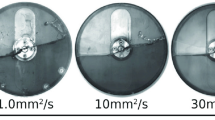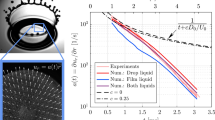Abstract
We present an analysis of the small amplitude shape oscillations of a superfluid helium drop surrounded by saturated helium vapor. The equations of the two-fluid model are used to describe the liquid motion within the drop. The calculations are performed for two different sets of boundary conditions at the surface of the drop. The first set corresponds to the physical situation in which no evaporation or condensation of helium takes place during the oscillation (no evaporation model), whereas the second set apply when the liquid at the surface of the drop is always in phase equilibrium with the vapor (equilibrium model). The theoretical results for frequency and damping rate are then compared with experimental data.
Similar content being viewed by others
REFERENCES
D. L. Whitaker, C. Kim, C. L. Vicente, M. A. Weilert, H. J. Maris, and G. M. Seidel, J. Low Temp. Phys. 113, 491 (1998).
Lord Rayleigh, Proc. Roy. Soc. Lond. 29, 71 (1879).
Lord Kelvin, in Mathematical and Physical Papers, Clay and Sons, London (1890).
H. Lamb, Hydrodynamics, 6th Ed., Cambridge University Press, Cambridge (1932) (reprinted by Dover, New York (1945)).
S. Chandrasekhar, Proc. Lond. Math. Soc. 9, 141 (1959).
S. Chandrasekhar, Hydrodynamic and Hydromagnetic Stability, Clarendon Press, Oxford (1961).
W. H. Reid, Quart. Appl. Math. 18, 86 (1960).
C. A. Miller and L. E. Scriven, J. Fluid Mech. 32, 417 (1968).
P. L. Marston, J. Acoust. Soc. Am. 67, 15 (1980).
A. Prosperetti, J. de Mech. 19, 149 (1980).
L. D. Landau and E. M. Lifshitz, Fluid Mechanics, Butterwoth-Heinenann, Oxford (1981), 2nd Ed., Ch. 16.
The density and viscosity of the normal fluid, the total density of the liquid, and the surface tension were taken from R. J. Donnelly, R. A. Riegelmann, and C. F. Barenghi, The Observed Properties of Liquid Helium at the Saturated Vapor Pressure, A Report of the Department of Physics, University of Oregon (1993), unpublished. This report contains recommended values of the normal fluid viscosity only down to 0.8 K. Below this temperature we used the viscosity calculated from the heat flow experiments of R. W. Whitworth, Proc. R. Soc. 246, 390 (1958). For the vapor viscosity we have used the recommended values from Y. S. Toulokian, S. C. Saxena, and P. Hestermans, Thermophysical Properties of Matter Vol. 11, IFI/ Plenum, New York (1979), for temperatures above 1.25 K, and the theoretical values of J. de Boer, Physica 10, 348 (1943) for lower temperatures. The density of the vapor was calculated from the saturated vapor pressure given in Donnely, Riegelmann, and Barenghi loc cit, under the assumption that the vapor can be treated as an ideal gas.
H. Wiechert, J. Phys. C 9, 553 (1976).
D. L. Cummings and D. L. Blackburn, J. Fluid Mech. 224, 395 (1991).
M. A. Weilert, D. L. Whitaker, H. J. Maris, and G. M. Seidel, J. Low Temp. Phys. 106, 101 (1997).
Lord Rayleigh, Phil. Mag. 14, 184 (1882).
R. Clift, J. R. Grace and M. E. Weber, Bubbles Drops and Particles, Academic Press, N.Y. (1978), Ch 10.
N. O. Young, J. S. Goldstein, and M. J. Block, J. Fluid Mech. 6, 350 (1959).
Author information
Authors and Affiliations
Rights and permissions
About this article
Cite this article
Whitaker, D.L., Kim, C., Vicente, C.L. et al. Theory of the Small Amplitude Shape Oscillations of a Helium-II Drop. Journal of Low Temperature Physics 114, 523–545 (1999). https://doi.org/10.1023/A:1021810422559
Issue Date:
DOI: https://doi.org/10.1023/A:1021810422559




